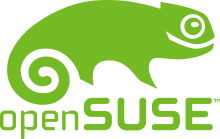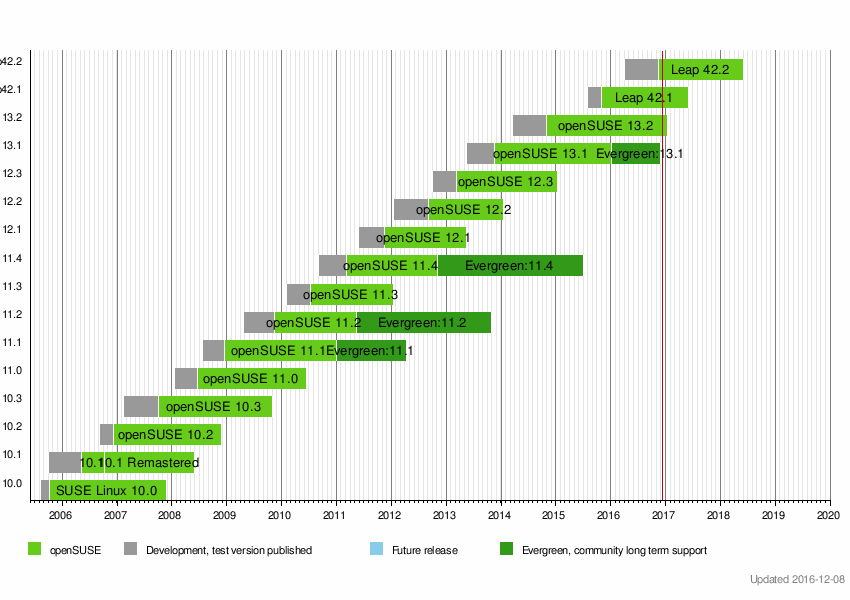OpenSUSE version history

openSUSE, a popular Linux distribution developed by the community-supported openSUSE Project and sponsored by a number of companies and individuals, most notably SUSE, AMD, B1 Systems, Heinlein Support and IP Exchange.[1] attempts to maintain, promote, improve and document the openSUSE Linux distribution.
Releases
10.x Series
The initial stable release from the openSUSE Project was SUSE Linux 10.0, released on October 6, 2005.[2] This was released as a freely downloadable ISO image and as a boxed retail package, with certain bundled software only included in the retail package.[3]
On May 11, 2006, the openSUSE Project released SUSE Linux 10.1, with the mailing list announcement identifying Xgl, NetworkManager, AppArmor and Xen as prominent features.[4]
For their third release, the openSUSE Project renamed their distribution, releasing openSUSE 10.2 on December 7, 2006. Several areas that developers focused their efforts on were reworking the menus used to launch programs in KDE and GNOME, moving to ext3 as the default file system, providing support for internal readers of Secure Digital cards commonly used in digital cameras, improving power management framework (more computers can enter suspended states instead of shutting down and starting up) and the package management system. This release also featured version 2.0 of Mozilla Firefox.
The fourth release, openSUSE 10.3, was made available as a stable version on October 4, 2007.[5] An overhaul of the software package management system (including support for 1-Click-Install), legal MP3 support from Fluendo and improved boot-time are some of the areas focused on for this release.
11.x Series
openSUSE 11.0 was released on June 19, 2008. It includes the latest version of GNOME and two versions of KDE (the older, stable 3.5.9 and the newer 4.0.4).[6][7] It comes in three freely downloadable versions: a complete installation DVD (including GNOME, KDE3, and KDE4), and two Live CDs (GNOME, and KDE4 respectively). A KDE3 Live CD was not produced due to limited resources.[7] Package management and installation were made significantly faster with ZYpp.[8]
openSUSE 11.1 was released on December 18, 2008. Updated software includes GNOME 2.24.1, Plasma 4.1.3 + K Desktop Environment 3.5.10, OpenOffice.org 3.0, VirtualBox 2.0.6, Compiz 0.7.8, Zypper 1.0.1, continued improvement in the software update stack, X.Org 7.4, Xserver 1.5.2, and Linux kernel 2.6.27.7.[9] openSUSE 11.1 was the first Evergreen supported release.[10]
openSUSE 11.2[11] was released on November 12, 2009. It includes Plasma 4.3, GNOME 2.28, Mozilla Firefox 3.5, OpenOffice.org 3.1, improved social network support, updated filesystems such as Ext4 as the new default and support for Btrfs, installer support for whole-disk encryption, significant improvements to YaST and zypper, and all ISO images are hybrid and now support both USB and CD-ROM boot.[12][13]
openSUSE 11.3 was released on July 15, 2010. It includes Plasma 4.4.4, GNOME 2.30.1, Mozilla Firefox 3.6.6, OpenOffice.org 3.2.1, SpiderOak support, support for the Btrfs filesytem and support for LXDE. It also updates the Linux kernel to version 2.6.34.[12]
openSUSE 11.4 was finished on March 3, 2011 and released on March 10, 2011. It includes Plasma 4.6.0, GNOME 2.32.1, Mozilla Firefox 4.0 beta 12, and switched from OpenOffice.org to LibreOffice 3.3.1. It updates the Linux kernel to version 2.6.37.[14]
12.x Series
openSUSE 12.1 was released on November 16, 2011. This includes Plasma 4.7 and GNOME 3.2 and Firefox 7.0.1. The Linux kernel was updated to 3.1.0[15] It also introduced an advanced disk snapshot tool, called Snapper, for managing Btrfs snapshots.[16] openSUSE 12.1 was also the first release of openSUSE to use systemd by default rather than the traditional System V init. Users can still select to boot to System V init at startup time.
openSUSE 12.2 was to be released on July 11, 2012, but was postponed due to persistent stability issues.[17] The final release candidate was eventually announced on August 2, 2012 and the final release date was September 6, 2012.[18] 12.2 includes the desktop environments Plasma 4.8, GNOME 3.4, Firefox 14.0.1, and Xfce 4.10 and now uses Plymouth and GRUB 2 by default.
openSUSE 12.3 was released on schedule on March 13, 2013. This includes Plasma 4.10, GNOME 3.6, Firefox 19.0, LibreOffice 3.6, and the removal of SuSEconfig. Also, the Live CD images were replaced with Live USB images, and an Xfce rescue image.
13.x Series
openSUSE 13.1 was released on November 19, 2013, and includes updates to Plasma 4.11, GNOME 3.10, Firefox 25.0, and LibreOffice 4.1. Some other changes include a YaST port to Ruby, the LightDM KDE greeter, and experimental Wayland support in the GNOME Shell and KDE Plasma Desktop. openSUSE 13.1 is an Evergreen supported release, meaning it will receive community patches for 18 months after SUSE support ends.[19]
openSUSE 13.2 was released on November 4, 2014, and includes updates to Plasma 4.11, KDE Applications 4.14, GNOME 3.14.1, Firefox 33.0 and LibreOffice 4.3.2.2.
Leap 42 series
The OpenSUSE team decided that the next version would be based on SUSE Linux Enterprise Server (SLES). They named it "Leap 42" (42 being the answer to life, the universe and everything).[20]
Leap 42.2 will feature KDE Plasma 5.8 LTS as its default desktop.[21]
Version history
The openSUSE project aims to release a new version every eight months. Since version 11.2, critical updates have been provided for two releases plus two months, which results in a support lifetime of 18 months.[22][23]
Starting with version 12.1, to add predictability and to prevent people from thinking the .0 releases are more major, the openSUSE version scheme has changed. All November releases have a .1, all July releases have a .2, and all March releases have a .3. Every two years, when another .1 version is released, the major version number is bumped up.
Starting with version Leap 42.1 (after version 13.2), each major release is expected to be supported for at least 36 months, until the next major version is available (e.g. 43.1), aligned with SUSE Linux Enterprise Releases. Each minor release (e.g. 42.1, 42.2, etc.) is expected to be released annually, aligned with SUSE Linux Enterprise Service Packs, and users are expected to upgrade to the latest minor release within 6 months of its availability, leading to a similar support lifecycle of 18 months as earlier.[24][25]
Evergreen[10] is a community effort to prolong maintenance of selected openSUSE versions after they reach official end-of-life.
| Name | Version | Codename | Release date[26] | End of life | Kernel version | |
|---|---|---|---|---|---|---|
| Regular[27] | Evergreen[10] | |||||
| SUSE Linux[28] | 10.0 | N/A | 2005-10-06 | 2007-11-30 | N/A | 2.6.13 |
| 10.1 | N/A | 2006-05-11 | 2008-05-31 | N/A | 2.6.16 | |
| openSUSE | 10.2 | N/A | 2006-12-07 | 2008-11-30 | N/A | 2.6.18 |
| 10.3 | N/A | 2007-10-04 | 2009-10-31 | N/A | 2.6.22 | |
| 11.0 | N/A | 2008-06-19 | 2010-06-26 | N/A | 2.6.25 | |
| 11.1 | N/A | 2008-12-18 | 2011-01-14 | 2012-04 | 2.6.27 | |
| 11.2 | Emerald | 2009-11-12 | 2011-05-12 | 2013-11 | 2.6.31 | |
| 11.3[29] | Teal | 2010-07-15 | 2012-01-16 | N/A | 2.6.34 | |
| 11.4[30] | Celadon | 2011-03-10 | 2012-11-05 | 2015-07 | 2.6.37 | |
| 12.1[31] | Asparagus | 2011-11-16 | 2013-05-15 | N/A | 3.1.0 | |
| 12.2[32] | Mantis | 2012-09-05 | 2014-01-15 | N/A | 3.4.6 | |
| 12.3[33] | Dartmouth | 2013-03-13 | 2015-01-01 | N/A | 3.7.10 | |
| 13.1[34] | Bottle | 2013-11-19 | 2016-01 | 2016-11[35] | 3.11.6 | |
| 13.2[34] | Harlequin | 2014-11-04 | 2017-01-16 | N/A | 3.16.6 | |
| openSUSE Leap | 42.1[36] | Malachite | 2015-11-04 | Q2 2017 | N/A | 4.1 |
| 42.2[37] | N/A | 2016-11-16 | Q2 2018 | N/A | 4.4 | |
| Tumbleweed [38] | rolling | N/A | rolling | N/A | N/A | 4.8.8 |
| Legend: Old version Older version, still supported Latest version Latest preview version Future release | ||||||

References
- ↑ "Sponsors - openSUSE". 2012-05-12. Retrieved 2012-05-12.
- ↑ CowboyNeal (October 5, 2006). "SUSE 10.0 OSS Released". Slashdot. Retrieved 2007-01-13.
- ↑ Harmon, Joe (September 19, 2005). "Packages on the retail version and not the OSS version of SUSE Linux 10.0". Novell.com. Retrieved 2007-01-13.
- ↑ Jaeger, Andreas (May 11, 2006). "SUSE Linux 10.1 Release". opensuse-announce mailing list. Retrieved 2007-01-13.
- ↑ Giannaros, Francis (October 4, 2007). "Announcing openSUSE 10.3 GM". openSUSE News. Retrieved 2007-10-08.
- ↑ "openSUSE 11.0 KDE4 inclusion".
- 1 2 "KDE with Stephan Binner".
- ↑ "Sneak Peeks at openSUSE 11.0: Package Management".
- ↑ "openSUSE 11.1 Released!".
- 1 2 3 "openSUSE Evergreen".
- ↑ "openSUSE 11.2 Review".
- 1 2 Yunashko, Bryen (July 15, 2010). "openSUSE 11.3 is here!". opensuse-announce mailing list. Retrieved 2010-07-15.
- ↑ "OpenSUSE 11.2". Archived from the original on September 6, 2009. Retrieved 2009-10-05.
- ↑ "openSUSE 11.4 Repository".
- ↑ "openSUSE 12.1 Repository".
- ↑ "Introducing Snapper".
- ↑ openSUSE 12.2 release delayed, team calls for a rethink, The Register, 2012-06-14
- ↑ Stephenson, Will (2012-08-02), openSUSE 12.2 RC2 Ready for a Final Test, openSUSE News, retrieved 2012-08-20
- ↑ "openSUSE 13.1: Ready for Action!".
- ↑ "Linux Top 3: VirtualBox 5, Point Linux 3.0 and OpenSUSE Leap 42.x". Linuxplanet.com. July 13, 2015. Retrieved December 12, 2015.
- ↑ url=https://news.opensuse.org/2016/09/22/new-leap-beta-adds-plasma-5-8-beta/
- ↑ Loeffler, Michael (August 14, 2009). "Change in maintenance for openSUSE 11.2 and future versions". opensuse-announce mailing list. Retrieved 2009-11-10.
- ↑ "openSUSE Lifetime (as of 2011)". Retrieved November 19, 2011.
- ↑ "openSUSE Lifetime (as of 2015)". Retrieved September 17, 2015.
- ↑ "openSUSE Roadmap (as of 2015)". Retrieved September 17, 2015.
- ↑ "openSUSE Roadmap".
- ↑ "openSUSE Lifetime".
- ↑ but done by openSUSE project
- ↑ Yunashko, Bryen (15 July 2010). "openSUSE 11.3 is here!". opensuse-announce mailing list. Retrieved 15 July 2010.
- ↑ "Portal 11.4: openSUSE 11.4 was released on Thursday the 10th of March 2011".
- ↑ "Portal 12.1: openSUSE 12.1 has been released on Wednesday, the 16th of November 2011".
- ↑ "Portal 12.2: openSUSE 12.2 has been released on Wednesday September 5th 2012".
- ↑ "Portal 12.3: openSUSE 12.3 has been released on Wednesday, March 13, 2013".
- 1 2 "Supported Regular distributions".
- ↑ "Evergreen EOL".
- ↑ "Release Notes openSUSE 42.1".
- ↑ "Optimal Release for Linux Professionals Arrives with openSUSE Leap 42.2". November 16, 2016.
- ↑ "Tumbleweed".
External links
- Official website
-
 Media related to openSUSE at Wikimedia Commons
Media related to openSUSE at Wikimedia Commons